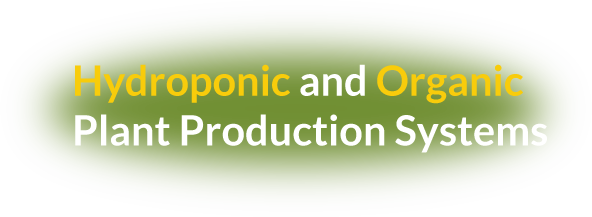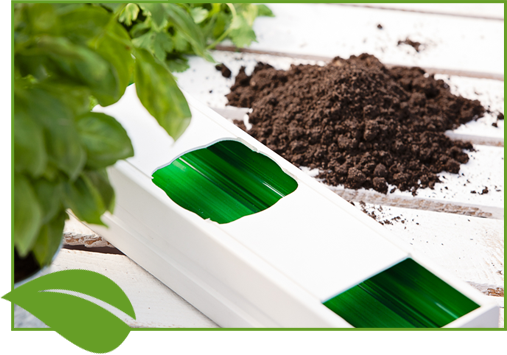

Hydroponically grown plants require much less land surface. Plants can be stacked (or even placed on multiple-story buildings, for high-density areas) with extreme efficiency – a hydroponic greenhouse can produce as much plant matter as a conventional field ten times the size. Read more >>
Hydroponics requires no soil whatsoever, meaning that farming can be done in areas with poor or even no soil – famously, Wake Island was hydroponically supplied with vegetables during. << Less

Hydroponically grown plants can be provided with the exact amount of water needed – not a drop more, not a drop less. In fact, the water use efficiency of hydroponics is astoundingly high – a properly-designed hydroponic setup will use 10% of the water it would take to grow in soil outdoors.

Pests and diseases are drastically reduced in hydroponics. Soil is taken out of the picture and replaced with one of the common hydroponic growing media. Eliminating soil also eliminates a lot of the different soil borne diseases and pests that plague traditional gardening.

Not only does growing hydroponically save you the time of weeding, pest control and watering, it also speeds up the growth of the plant. If you’re growing outdoors, that means you get to squeeze in more harvest cycles before your growing season ends. Read more >>
You also get to observe the growth of plants at a quicker pace and learn about all of the different things you could do to improve the growth much quicker.

Almost any kind of leaf lettuce will grow quickly in a hydroponic system. Some of the types to try include Romaine, bibb and butter crunch, all of which are ready in three to four weeks. Head lettuce, such as iceberg, will grow well, but the heads take about twice as long to be ready as the leafy types. When growing leaf lettuce, harvest just the outer leaves of the plants and leave the inner leaves to grow, to give you a crop you can harvest almost every day.

Herbs are generally easy to grow in hydroponic systems, and they will grow as much as 25 percent faster using this method than when using conventional gardening methods. The best choices for hydroponic gardening are mints, such as peppermint and spearmint, as well as basil, marjoram and oregano. Other herbs that are rapid growers are chives and thyme. All of these crops germinate quickly and can be harvested just a few weeks after planting, though growers who want large plants may decide to wait a little longer.

Many common greens will grow much faster in a hydroponic system than they will when grown in soil. Arugula, a slightly peppery salad green, is ready to harvest as little as three weeks after planting. Mustard greens, Swiss chard, spinach, kale and watercress are all fast-growing plants that will thrive in a hydroponic system, and typically you can begin harvesting them within a month of planting. Harvest them early, when they are small, to get tender young greens, or allow them to get larger if you prefer your greens to have more size or a stronger flavor.

Various factors impact how quickly plants grow in a hydroponic system. Temperatures that are too hot or too cold can have a big impact, and can even cause plants to stop growing. Most plants will grow well with daytime temperatures of about 75 to 80 degrees and nighttime temperatures around 65, but cold weather plants, such as lettuce, prefer temperatures about 10 degrees lower. Light is another essential factor, and plants that don’t get enough light won’t grow fast, if they grow at all. Hydroponic plants will grow outdoors or in greenhouses that allow for plenty of natural light.
<< Less

Lettuce
Almost any kind of leaf lettuce will grow quickly in a hydroponic system. Some of the types to try include Romaine, bibb and butter crunch, all of which are ready in three to four weeks. Head lettuce, such as iceberg, will grow well, but the heads take about twice as long to be ready as the leafy types. When growing leaf lettuce, harvest just the outer leaves of the plants and leave the inner leaves to grow, to give you a crop you can harvest almost every day.

Herbs
Herbs are generally easy to grow in hydroponic systems, and they will grow as much as 25 percent faster using this method than when using conventional gardening methods. The best choices for hydroponic gardening are mints, such as peppermint and spearmint, as well as basil, marjoram and oregano. Other herbs that are rapid growers are chives and thyme. All of these crops germinate quickly and can be harvested just a few weeks after planting, though growers who want large plants may decide to wait a little longer.

Other greens
Many common greens will grow much faster in a hydroponic system than they will when grown in soil. Arugula, a slightly peppery salad green, is ready to harvest as little as three weeks after planting. Mustard greens, Swiss chard, spinach, kale and watercress are all fast-growing plants that will thrive in a hydroponic system, and typically you can begin harvesting them within a month of planting. Harvest them early, when they are small, to get tender young greens, or allow them to get larger if you prefer your greens to have more size or a stronger flavor.

Considerations
Various factors impact how quickly plants grow in a hydroponic system. Temperatures that are too hot or too cold can have a big impact, and can even cause plants to stop growing. Most plants will grow well with daytime temperatures of about 75 to 80 degrees and nighttime temperatures around 65, but cold weather plants, such as lettuce, prefer temperatures about 10 degrees lower. Light is another essential factor, and plants that don’t get enough light won’t grow fast, if they grow at all. Hydroponic plants will grow outdoors or in greenhouses that allow for plenty of natural light.
<< Less






